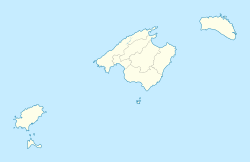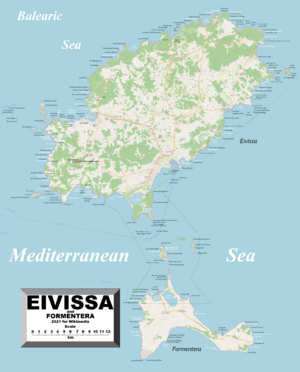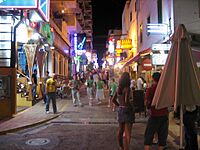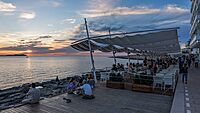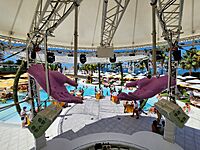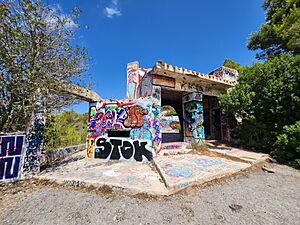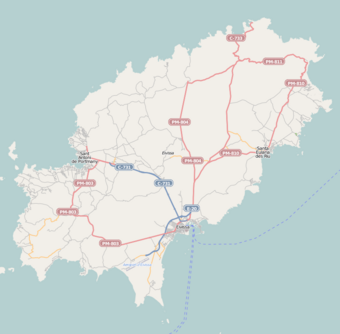Ibiza facts for kids
|
Native name:
Eivissa
|
|
|---|---|
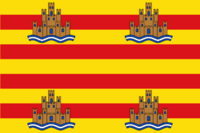
Flag of Ibiza
|
|

Satellite view (2013)
|
|
|
Satellite view (2013)
|
|
| Geography | |
| Location | Balearic Sea |
| Coordinates | 38°59′N 1°26′E / 38.98°N 1.43°E |
| Archipelago | Balearic Islands, Pityusic Islands |
| Area | 571.6 km2 (220.7 sq mi) |
| Highest elevation | 475 m (1,558 ft) |
| Highest point | Sa Talaiassa |
| Administration | |
|
Spain
|
|
| Autonomous Community | Balearic Islands |
| Province | Balearic Islands |
| Capital city | Ibiza Town |
| Largest settlement | Ibiza Town (pop. 51,872) |
| Government | Island Council of Ibiza |
| President | Vicente Marí (PP) |
| Demographics | |
| Population | 159,180 (1 January 2023) |
| Pop. density | 278.0 /km2 (720 /sq mi) |
| Languages | Catalan, Spanish |
| Official name | Ibiza, Biodiversity and Culture |
| Type | Mixed |
| Criteria | ii, iii, iv, ix, x |
| Designated | 1999 (23rd session) |
| Reference no. | 417 |
| Region | Southern Europe |
Ibiza is a beautiful Spanish island located in the Mediterranean Sea. It is off the eastern coast of Spain. The island is about 150 kilometers (93 miles) from the city of Valencia. Ibiza is the third largest of the Balearic Islands by size. However, it is the second largest by how many people live there.
The biggest towns on the island are Ibiza Town, Santa Eulària des Riu, and Sant Antoni de Portmany. The highest point on Ibiza is called Sa Talaiassa. It is 475 meters (1,558 feet) above sea level.
Ibiza is famous for its lively music and entertainment scene in the summer. This attracts many visitors. The island's government is also working to make tourism more family-friendly. Ibiza is a UNESCO World Heritage Site. Ibiza and the nearby island of Formentera are often called the Pine Islands, or "Pityuses".
Contents
Understanding Ibiza's Names
The name Ibiza is usually pronounced "ib-EE-thuh" in British English. In American English, it is often pronounced "ib-EE-zuh" or "ee-BEE-suh".
Long ago, Phoenician settlers called the island Ibossim. This name might have meant "Fragrance Island" because of the many sweet-smelling plants. Another idea is that it meant "Dedicated to Bes", an ancient god. The Romans later called it Ebusus.
The ancient Greeks called Ibiza and Formentera the Pityoûssai. This likely meant "Pine-Covered Islands". The modern names in Catalan (Pitiüses) and Spanish (Pitiusas) still use this Greek root.
The island's name in Catalan is Eivissa. In Spanish, it is Ibiza. In the 1700s and 1800s, the British often called the island Ivica.
A Brief History of Ibiza
Early Settlers and Ancient Times
In 654 BC, people from Phoenicia started a port on Ibiza. Phoenicia was a powerful trading civilization. Later, Carthage, another former Phoenician settlement, took control of the island. Ibiza was important for making dye, salt, fish sauce, and wool.
A special place for the goddess Tanit was built in a cave. Ibiza became a major trading spot in the Mediterranean Sea. The island even set up its own trading posts on nearby Majorca. Many skilled slingers from the Balearic Islands joined the Carthaginian army.
During the Second Punic War, Roman brothers tried to attack Ibiza in 217 BC. But the island stayed loyal to Carthage. After the war, Ibiza made a good deal with the Romans. This agreement saved the island from being destroyed. It also allowed Ibiza to keep its own traditions and even its own money for a long time.
From Roman Rule to Modern Spain
After the Roman Empire fell, Ibiza was ruled by the Vandals and then the Byzantine Empire. In 902 AD, Muslims conquered the island. Most local people became Muslim, and new settlers from North Africa arrived. Under Muslim rule, Ibiza (called Yabisah) became closely linked to the city of Dénia in Spain.
In 1110, the Norwegian King Sigurd I of Norway invaded Ibiza during his journey to Jerusalem. He had already conquered other cities to weaken Muslim control in Spain.
In 1235, the Crown of Aragon (a kingdom in Spain) conquered Ibiza. The Muslim people living there were moved away. Christians from Girona, a city in Spain, came to live on the island. Ibiza had its own local government until 1715. That year, King Philip V of Spain removed the island's self-rule.
In the late 1970s, Spain became a democracy again. This led to the Statute of Autonomy of the Balearic Islands. Today, Ibiza is part of the Balearic Islands' self-governing region. This region also includes Majorca, Menorca, and Formentera.
Ibiza as a World Heritage Site
Even though Ibiza is known for its fun atmosphere, large parts of the island are recognized by UNESCO as World Heritage Sites. This means they are very important for everyone in the world to protect.
One important example is the old town of Ibiza City. Its Renaissance walls were given World Heritage status in 1999. These walls are special because they are some of the few Renaissance walls that were not torn down. Parts of the older medieval wall can still be seen.
Other important cultural sites include the remains of the first Phoenician settlement at Sa Caleta. Also, the Posidonia oceanica plant, which grows in the ocean around Ibiza, is part of UNESCO's World Heritage. This plant is very important for the sea environment.
Geography of Ibiza
Ibiza is a rocky island covering an area of 572.56 square kilometers (221.07 square miles). It is about one-sixth the size of Majorca. However, it is five times bigger than Mykonos in Greece. It is also ten times larger than Manhattan in New York City.
Ibiza is the largest of the western Balearic islands. This group is called the Pityusic Islands or "Pine Islands." It includes Ibiza and Formentera. The entire Balearic island chain has over 50 islands. Many of these islands have no people living on them. The highest point on Ibiza is Sa Talaiassa. It is 475 meters (1,558 feet) tall.
How Ibiza is Governed
Ibiza is part of the autonomous community of the Balearic Islands. The capital city of this community is Palma, located on the island of Majorca. Ibiza is divided into five smaller areas called municipalities.
| Map | Municipality | Area in square km |
Population 1 Jan 2023 |
|---|---|---|---|
 |
Sant Josep de sa Talaia | 159.4 | 30,340 |
| Sant Antoni de Portmany | 126.8 | 28,551 | |
| Sant Joan de Labritja | 121.7 | 6,809 | |
| Santa Eulària des Riu | 153.6 | 41,608 | |
| Vila d'Eivissa | 11.1 | 51,872 | |
| Totals | 572.6 | 159,180 |
In 2001, these municipalities had a total of 88,076 people. By the start of 2023, this number grew to about 159,180. This fast growth is partly because many foreign residents have registered to live on the island.
The island has its own self-governing body called the Ibiza Island Council. Before 2007, Formentera was also part of this council.
Ibiza's Climate
Ibiza has a warm and mild climate all year round. The average yearly temperature is about 18.3°C (64.9°F). Ibiza gets a lot of sunshine, around 2700-2800 hours each year. It also has a small amount of rain, usually between 400 to 450 mm (16 to 18 inches) per year.
The average high temperature is 22.2°C (72.0°F), and the average low is 14.3°C (57.7°F). Winters are mild and a bit rainy, making the island green from November to April. Summers are hot and a little humid, but with very little rain. When it does rain in summer, it often comes with thunderstorms.
In January, the coldest month, the average high is 15.7°C (60.3°F). The average low is 8.1°C (46.6°F). In August, the warmest month, the average high is 30.3°C (86.5°F). The average low is 22.2°C (72.0°F). Extreme temperatures are rare because the sea helps keep the weather steady. You can usually enjoy the beaches from May to November.
| Climate data for Eivissa Airport 6 metres (20 feet) (1981–2010) | |||||||||||||
|---|---|---|---|---|---|---|---|---|---|---|---|---|---|
| Month | Jan | Feb | Mar | Apr | May | Jun | Jul | Aug | Sep | Oct | Nov | Dec | Year |
| Record high °C (°F) | 24.7 (76.5) |
23.5 (74.3) |
26.5 (79.7) |
27.8 (82.0) |
31.0 (87.8) |
36.5 (97.7) |
36.6 (97.9) |
36.6 (97.9) |
38.4 (101.1) |
32.0 (89.6) |
28.4 (83.1) |
23.8 (74.8) |
38.4 (101.1) |
| Mean daily maximum °C (°F) | 15.7 (60.3) |
15.9 (60.6) |
17.7 (63.9) |
19.7 (67.5) |
22.7 (72.9) |
26.8 (80.2) |
29.7 (85.5) |
30.3 (86.5) |
27.7 (81.9) |
24.0 (75.2) |
19.6 (67.3) |
16.7 (62.1) |
22.2 (72.0) |
| Daily mean °C (°F) | 11.9 (53.4) |
12.1 (53.8) |
13.7 (56.7) |
15.6 (60.1) |
18.6 (65.5) |
22.6 (72.7) |
25.6 (78.1) |
26.3 (79.3) |
23.8 (74.8) |
20.2 (68.4) |
15.9 (60.6) |
13.1 (55.6) |
18.3 (64.9) |
| Mean daily minimum °C (°F) | 8.1 (46.6) |
8.3 (46.9) |
9.6 (49.3) |
11.4 (52.5) |
14.6 (58.3) |
18.4 (65.1) |
21.4 (70.5) |
22.2 (72.0) |
19.9 (67.8) |
16.5 (61.7) |
12.3 (54.1) |
9.5 (49.1) |
14.3 (57.7) |
| Record low °C (°F) | −1.2 (29.8) |
0.2 (32.4) |
1.0 (33.8) |
3.4 (38.1) |
7.6 (45.7) |
10.0 (50.0) |
15.9 (60.6) |
16.5 (61.7) |
12.1 (53.8) |
8.5 (47.3) |
2.4 (36.3) |
1.1 (34.0) |
−1.2 (29.8) |
| Average precipitation mm (inches) | 37 (1.5) |
36 (1.4) |
27 (1.1) |
31 (1.2) |
27 (1.1) |
11 (0.4) |
5 (0.2) |
18 (0.7) |
57 (2.2) |
58 (2.3) |
53 (2.1) |
52 (2.0) |
413 (16.3) |
| Average precipitation days (≥ 1 mm) | 5 | 5 | 3 | 4 | 3 | 1 | 1 | 2 | 4 | 6 | 6 | 5 | 45 |
| Average snowy days | 0.1 | 0.0 | 0.0 | 0.0 | 0.0 | 0.0 | 0.0 | 0.0 | 0.0 | 0.0 | 0.0 | 0.0 | 0.1 |
| Mean monthly sunshine hours | 162 | 166 | 211 | 246 | 272 | 299 | 334 | 305 | 236 | 205 | 157 | 151 | 2,744 |
| Percent possible sunshine | 52 | 54 | 57 | 63 | 63 | 67 | 72 | 70 | 66 | 60 | 52 | 54 | 61 |
| Source 1: Agencia Estatal de Meteorología | |||||||||||||
| Source 2: Agencia Estatal de Meteorología, | |||||||||||||
| Climate data for Ibiza | |||||||||||||
|---|---|---|---|---|---|---|---|---|---|---|---|---|---|
| Month | Jan | Feb | Mar | Apr | May | Jun | Jul | Aug | Sep | Oct | Nov | Dec | Year |
| Average sea temperature °C (°F) | 14.7 (58.5) |
14.3 (57.7) |
14.5 (58.0) |
16.3 (61.4) |
19.1 (66.3) |
22.5 (72.6) |
25.1 (77.1) |
26.2 (79.1) |
25.2 (77.4) |
22.7 (72.9) |
19.6 (67.3) |
16.6 (61.8) |
19.7 (67.5) |
| Mean daily daylight hours | 10.0 | 11.0 | 12.0 | 13.0 | 14.0 | 15.0 | 15.0 | 14.0 | 12.0 | 11.0 | 10.0 | 9.0 | 12.2 |
| Average ultraviolet index | 2 | 3 | 5 | 6 | 8 | 9 | 9 | 8 | 6 | 4 | 3 | 2 | 5.4 |
| Source #1: seatemperature.org | |||||||||||||
| Source #2: Weather Atlas | |||||||||||||
People of Ibiza
The number of people living on Ibiza has grown quickly. In 2001, there were about 88,076 residents. By 2023, this number had risen to 159,180.
About 55% of the island's residents were born in Ibiza. Around 35% are people who moved from mainland Spain. The rest, about 10% to 15%, are foreign citizens from Europe and other countries. The most common visitors from other countries are German, British, French, Italian, and Dutch.
Some famous people have connections to Ibiza. The Spanish composer Miguel Roig-Francolí was born there. The politician Abel Matutes, who was Spain's Minister of Foreign Affairs, also came from Ibiza.
Languages Spoken on Ibiza
Eivissenc is the local way of speaking Catalan on Ibiza and nearby Formentera. Catalan is an official language on the island, along with Spanish.
Because many tourists and people from other countries live on Ibiza, other languages are also widely spoken. These include English, French, German, and Italian.
Tourism and Fun Activities
Ibiza's Lively Entertainment Scene
Ibiza is a very popular place for tourists. It is especially known for its lively music and entertainment scene. This scene is mainly found in Ibiza Town and Sant Antoni. Ibiza has even been called the "Party Capital of the world."
Since 2005, the Ibiza Rocks event has changed how people see Ibiza's music scene. Famous bands like Arctic Monkeys and The Prodigy have played there.
The main tourist season usually starts at the end of April. Big opening parties happen at Ibiza's music venues over three weeks. These parties often happen around the same time as the International Music Summit. This is a three-day event that celebrates electronic music. It features speakers, classes, and performances. The first venues to open are usually Ushuaïa, Hï, Amnesia, and Pacha. The season ends around mid-October with closing parties.
Other Fun Things to Do
The island's government is working to make tourism more family-friendly. They want to attract a wider variety of visitors. For example, they have rules that all music venues must close by 6:00 AM. Also, all new hotels must be 5-star.
Ibiza offers many activities beyond its music scene. Visitors can enjoy a hot-air balloon ride or go surfing. You can also explore the Cave Can Mark or visit the Cap Blanc's Aquarium.
Island Development and Growth
Ibiza has seen a lot of building projects as tourism has grown. Some have been very successful. Others, like the "Festival Club" from the 1970s, were not. The Festival Club was a huge restaurant and music venue that only operated for three summers. Its ruins can still be seen today.
Since 2009, more and more tourists have visited Ibiza each year. In 2012, almost 6 million people traveled through Ibiza Airport. The summer season is busiest between June and September. The island's luxury tourism market has also grown a lot. There are new fancy restaurants, music venues, and improvements to the marina in Ibiza Town.
However, Ibiza's popularity has also caused some challenges. There can be shortages of drinking water. The island's services, like roads and waste management, can become very busy. Because of this, a "Sustainable Tourism Tax" was started on July 1, 2016. This tax helps manage tourism and protect the island. The Minister of Tourism has also said that no new buildings can be built in certain areas. With many tourist beds and a large population, the island cannot support much more tourism.
Getting Around Ibiza
Ibiza has its own airport. Many international flights come here during the summer, especially from Europe and the United Kingdom.
You can also take ferries from the harbors in Sant Antoni and Ibiza Town. These ferries go to cities like Barcelona, Majorca, Dénia, and Valencia. There are also ferries to Formentera from Sant Antoni, Ibiza Town, Santa Eulària, and Figueretes–Platja d'en Bossa.
Public buses run between Sant Antoni and Ibiza Town every 15 minutes in summer. In winter, they run every half-hour. There are also buses from Sant Antoni to popular beaches like Cala Bassa and Cala Conta. You can also take a bus to the airport. From Ibiza Town, buses go to Platja d'en Bossa, Ses Salines, the airport, and Santa Eulària. There is even a special late-night bus line called the Disco Bus that stops at various music venues.
Images for kids
-
Es Vedrà (Sant Josep de sa Talaia)
See also
 In Spanish: Ibiza para niños
In Spanish: Ibiza para niños


